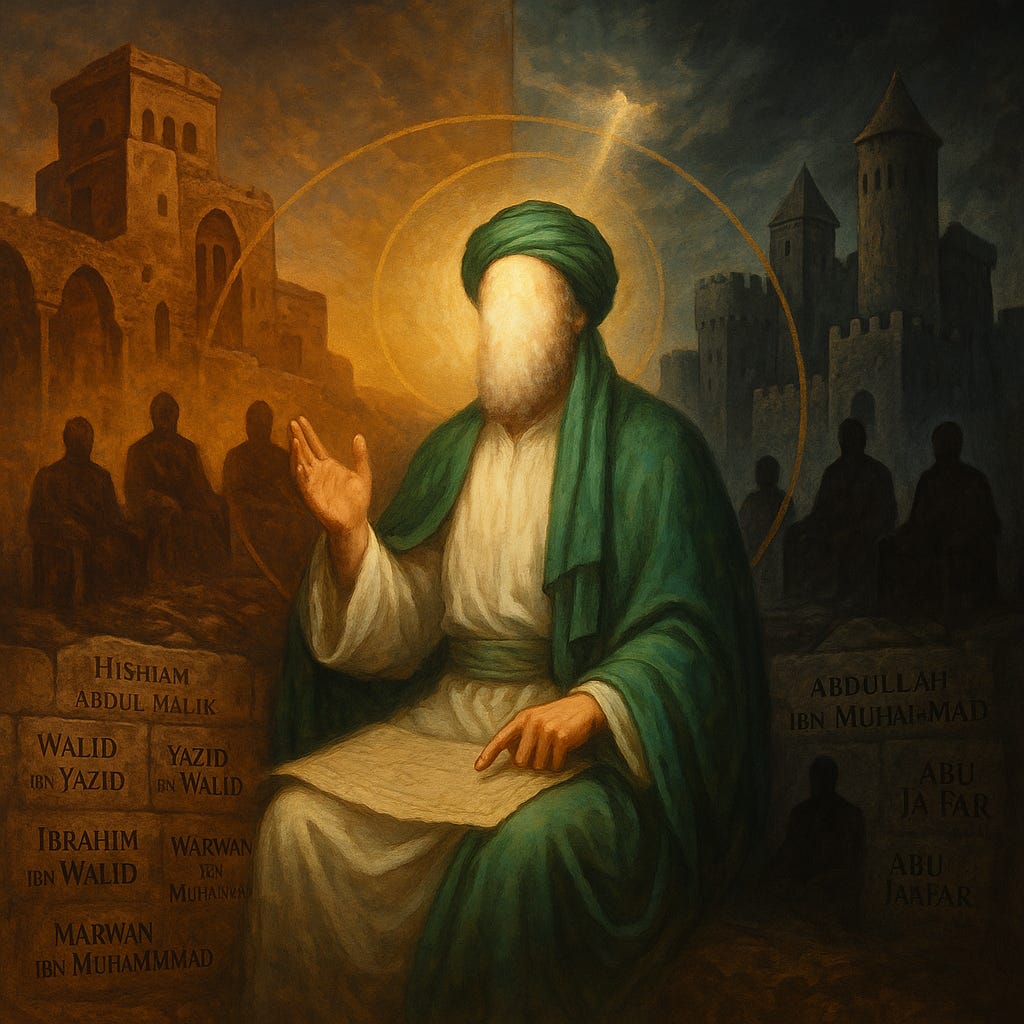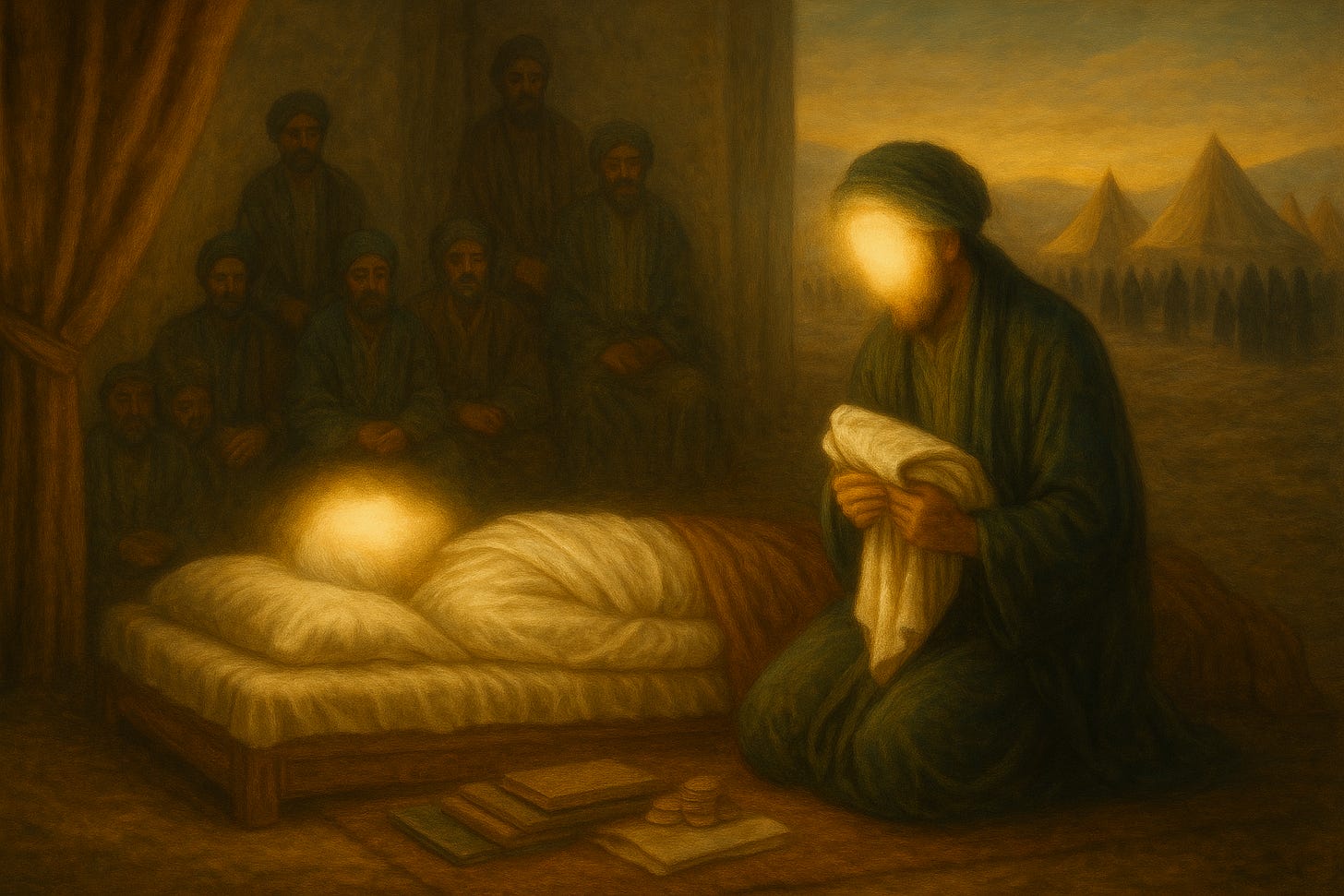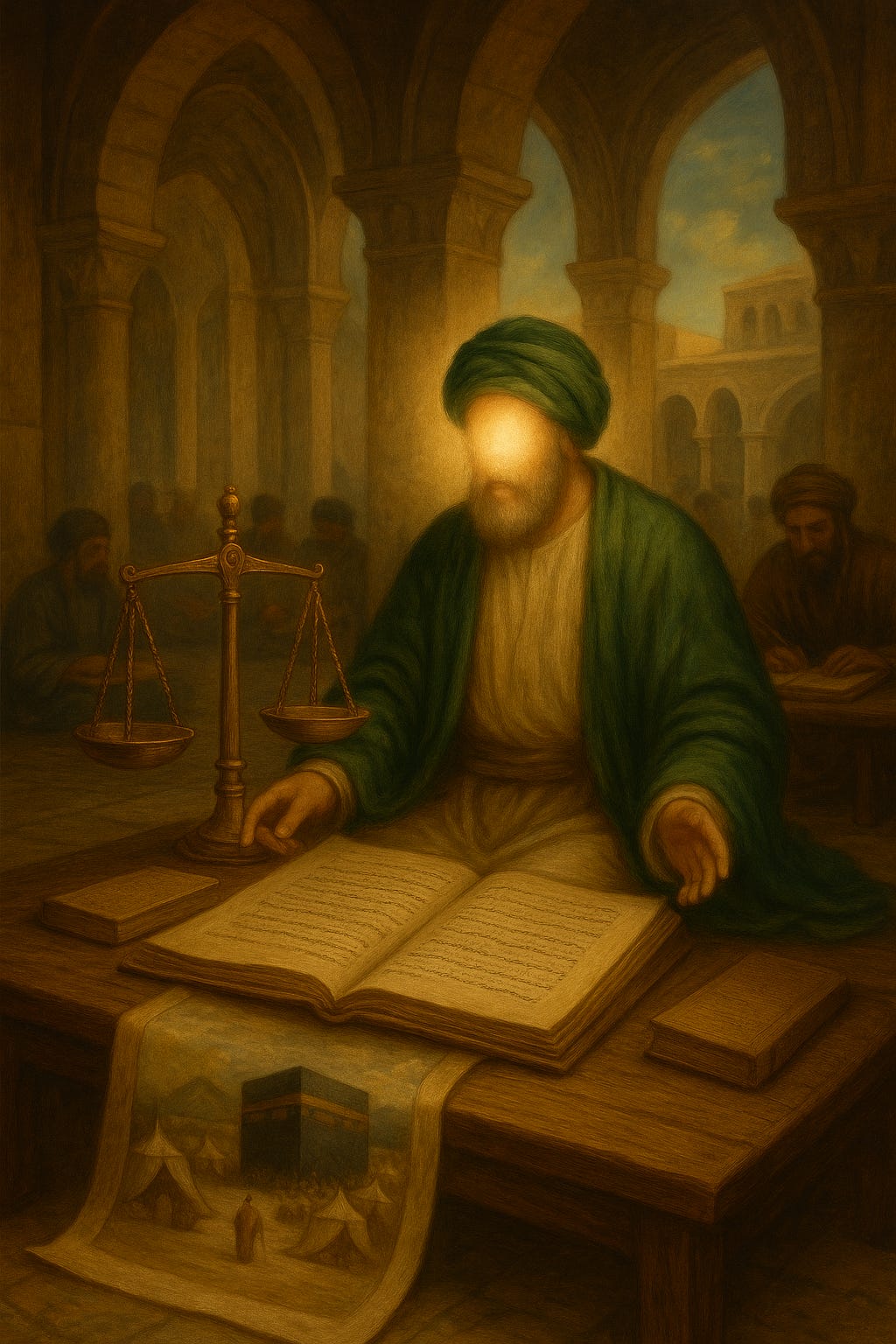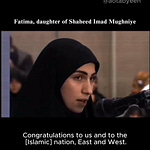In His Name, the Most High
بِسْمِ ٱللّٰهِ ٱلرَّحْمٰنِ ٱلرَّحِيمِ
ٱلْحَمْدُ لِلّٰهِ رَبِّ ٱلْعَالَمِينَ وَصَلَّى ٱللّٰهُ عَلَىٰ سَيِّدِنَا مُحَمَّدٍ وَعَلَىٰ أَهْلِ بَيْتِهِ ٱلطَّيِّبِينَ ٱلطَّاهِرِينَ ٱلْمَعْصُومِينَ، أَمَّا بَعْدُ
السَّلَامُ عَلَيْكُمْ وَرَحْمَةُ اللَّهِ وَبَرَكَاتُهُIn the name of God, the Most Gracious, the Most Merciful.
All praise is due to God, the Lord of all worlds, and may blessings be upon our Master Muhammad and upon his pure, purified, and infallible household. As for what follows:
Peace be upon you, and the mercy of God, and His blessings.
Birth and Death Date (Including Family Details)
Imam Ja’far ibn Muhammad al Sadiq (AS), the sixth holy Imam of the Muslims was born in Medina on the 17th of Rabi ul-Awaal 80 AH or according some narrations he was born in 83 AH. He shared the same birth date as his great grandfather the Holy Prophet (SAAW). He attained martyrdom on 25th Shawwal 148 AH. Although there are some discrepancies surrounding the actual date of his martyrdom, it is generally accepted that this occurred during the Islamic month of Shawwal.
His father was the 5th holy Imam Muhammad al Baqir (AS) and his mother was a lady by the name of Umm Farwah who was the granddaughter of Muhammad ibn Abu Bakr, the prominent companion and adopted son of Imam Ali (AS). She was a prominent student of the 5th holy Imam and was also active in disseminating knowledge amongst the women.
Titles and Teknonyms
Amongst the titles of Imam Ja’far al-Sadiq are the following.
Al-Sadiq - Meaning Truthful, Honest. This is a title which he shared with great grandfather the Holy Prophet (SAAW).
Al Sabir - Meaning the Steadfast. This title was given to him as he was able to remain steadfast and resolute in his mission, despite the plots and schemes of his enemies.
Al-Fadhil - Meaning the virtuous. He was given this title because he was the best and most knowledgeable person of his era. Not only in religion but also in scientific matters.
Al-Tahir - Meaning the pure. He was given this title on account of his pure mannerisms, behaviour and tendencies.
Amoud al-Sharraf - The pole of honour. He was given this title on account of him being the pride and the honour for the Muslim community.
Al-Qaim - Meaning the undertaker of the mission. He was given this title on account of his reviving and defending the true religion of Prophet Mohammed (SAW).
Al-Kafil - Meaning the supporter. He was given this title on account of his support for the orphans and needy within the society and his spending on their needs.
Al-Munji - Meaning the saviour. He was given this title on account of his ability to guide and save those who followed and sought refuge in him.
His kunya or teknonyms were Abu Abdullah a name which he shared with his great grandfather Imam Hussain (AS). He was also referred to as Abu Ismael or Abu Musa on account of these being the names of his sons.
Overview of his Life (Including Rulers he Lived Under)
Imam Ja’far al Sadiq (AS) lifespan of around 64 years was greater than any of the Imams of Ahlul Bayt.
Also his period of Imamate which lasted around 31 years was greater than any of the other Imams and saw a period of great social and political change within the Muslim nation.
Imam Sadiq (AS) was a contemporary of no less than seven rulers or caliphs, five from the Bani Umayyah these being:
Hisham ibn Abdul Malik,
Walid ibn Yazid,
Yazid ibn Walid,
Ibrahim ibn Walid and
Marwan ibn Muhammad (also known as Marwan Himar)
And from the Bani Abbas the rulership of:
Abdullah ibn Muhammad (known as Saffah) and
Abu Ja’far (known as Mansoor al Dawaniqi).
Time Spent with his Grandfather, Imam Sajjad (AS)
The first twelve years of Imam Sadiq (AS) life were spent under the nurture and guidance of his grandfather Imam Zayn ul-Abidin (AS), where he developed his moral and spiritual traits, as well as understanding of worship and obedience to Allah (SWT).
He saw how his grandfather would lament and shed tears for the tragedy of Karbala and the martyrdom of his father Imam Hussain (AS), and this greatly impacted the young Imam Sadiq (AS).
He also saw how his grandfather would help the poor and destitute by sacrificing a ewe every night during the holy month of Ramadhan and then cooking it’s meat into a stew and distributing it to the needy.
Imam Sadiq (AS) became fully developed and ready to carry out his mission as a result of training received from his grandfather.
When Imam Sajjad (AS) was martyred as a result of the poison given to him by the tyrant al-Walid bin Abd al Malik, Imam Sadiq (AS) saw the grief and sadness of his father Imam Baqir (AS) and this also affected him as well as he too had lost the person who taken care of him and influenced him the most during his young life.
Time Spent with his father, Imam Baqir (AS)
The next nineteen years of Imam Sadiq (AS) were spent under the direct supervision of his father Imam Muhammad Baqir (AS).
The Imam Baqir (AS) had established a university inside the mosque of the Holy Prophet (SAW), where he expanded on the teachings of his father Imam Sajjad (AS), as well as developing new subjects.
Imam Sadiq (AS) was an active participant in the lectures of his father and the most outstanding of all of the students, despite his young age.
An incident occurred during the time of the ruler Walid bin Abdul Malik who paid a visit to Medina to inspect the work which was being carried out to expand the Prophet’s mosque. Upon entering he saw that the lecture of Imam Baqir (AS) was going on and that there was a young boy present, who was actively participating in the discussions.
Imam Baqir (AS) was delivering a lecture on Geography and Walid asked him about the subject which was being taught. Imam Baqir (AS) explained that the subject was:
“The Science which talks about the Earth, the Sky, the Sun and the Stars.”
Walid became curious about the young boy who was in attendance and asked him the following questions. He enquired about his name and Imam Sadiq (AS) replied:
“My name is Ja’far”
He then asked a number of difficult questions all of which he was successfully able to answer. He then turned to his father Imam Baqir and told him:
“Your son will be the greatest scientist of the age”
He was forced to go to Damascus (Sham) accompanying his father due to the pressure and harassment of the ruler Husham ibn Abdul Malik.
The ruler was very rude and angry towards the Imam Baqir and would try and ask him difficult questions, which he was successfully able to answer.
In order to humiliate the Imam, he arranged an archery challenge where the Imam was told to fire arrows from a bow at a target.
The Imam refused to participate in the challenge but the ruler forced him to participate. The Imam successfully fired all the arrows in the exact centre of the target and each arrow pierced the one in front of it, in exact alignment.
This feat astonished all of the onlookers who could not believe what they were witnessing.
The people of Sham also treated the Imam with great contempt and closed their shops on him.
The Imam climbed upon a mountain and addressed the people saying:
“O cruel citizens of the city. I am what Allah (SWT) has left on the earth”
He then proceeded to recite Ayat 86 of Surah Hud.
“That which remains with Allah is better for you if you are believers, and I am not a keeper over you”
Once the ayat had been recited a voice was heard from one of the graveyards:
“O tribesmen, this is truly the invitation of Prophet Shuayb (AS). If you do not open your shops for this man, you will be punished from the earth and the sky.”
Upon hearing this warning the people became scared and they all ran to open their shops.
When the ruler Husham received the news about what had happened, he became furious and was determined to finish Imam Baqir (AS) once and for all.
He arranged for poison to be sent to his representative in Medina which was to be given to the Imam in his food and drink.
The plan to assassinate Imam Baqir (AS) through poison was successful and he became sick due to it’s effects, which spread throughout his whole body.
The Will of his Father
In his will, Imam Baqir (AS) nominated his son Imam Ja’far al Sadiq (AS) as his successor. He also left three requests for him to fulfil.
To take care of his companions, to ensure that their financial needs are taken care of so they would not be distracted from seeking knowledge.
To place the shirt which he used to wear during his prayers inside his coffin, so that this would act as a witness to his sincere worship of Allah.
To arrange mourning ceremonies for him in Mina during the Hajj pilgrimage for the next ten years and to provide the funds from his endowment. The purpose of these ceremonies was to show the oppression and injustice carried out against him by the Umayyad rulers.
Imam’s University and Prominent Students
Imam Ja’far Sadiq continued the work of his father and expanded the University he had established, until it reached new heights. Over 4000 students were being trained in many different disciplines. Amongst the important subjects which were being taught and developed at that time were the following:
Jurisprudence (Islamic Law)
This is one of the most important sciences to be developed because for the first time a comprehensive list of rulings of many subjects became available for the Shia and the followers of Ahlul Bayt. For example the rulings for Hajj pilgrimage had not been fully expounded until Imam Sadiq (AS). Hence the Shia became known as the Ja’fari school.
Traditions (Hadith)
Many traditions from Holy Prophet (SAW) and the Imams were passed on during the time of Imam Baqir (AS) and Imam Sadiq (AS).
During the early part of Islam after the passing of the Holy Prophet there had been a blanket ban on recording Hadith on the grounds that people may mistake these for the words of the Qur’an.
During the Umayyad period many false and fabricated Hadith began to be spread amongst the people and because most of the genuine Hadith of the Prophet had not been written down or recorded, many people were unable to discern true and false hadith.
Imam Sadiq (AS) taught and trained many of his students to memorise and transmit the true Hadith and for the first time the Shia had a true reference and source for their Hadith literature.
Also the sciences and methodologies for discerning true and false hadith were developed. Amongst those Imam Sadiq (AS) trained in this field were the following: Zurarah bin A’yan, Abu Basir, Burayd ibn Muawiya and many others.
It is interesting to note that Muhammad ibn Ismail al-Bukhari who came several years after Imam Sadiq and whose work is considered an authentic source for the Ahl us-Sunnah did not include even a single Hadith from Imam Sadiq.
Quranic Sciences
The Quranic sciences which included recitation and interpretation and exegeses of Qur’an.
Medicine
The science of medicine became highly developed and physicians from foreign lands including Indian physicians who were the most advanced of that time, were astonished the treatments and methods which had been developed.
Chemistry (Alchemy)
The science of Chemistry (or alchemy as it was originally known) was developed by one of the prominent companions Jabir bin Hayyan who wrote a large number of thesis on this many other of the natural sciences under the direct supervision of Imam Sadiq (AS).
Debate and Discussion
Other scholarly and theological debates were occurring during period and the Imam trained many students to be able to debate and discuss. Amongst the most prominent of these was a man by the name of Husham ibn Hakam who was highly trained in theology and expert in debate who used to defend the beliefs and positions of the Shia school.
Social and Political Movements and Circumstances
Whilst the main focus for Imam Sadiq (AS) was the development of the University and the spread of knowledge, he was not aloof from politics and the affairs of the Muslims as has been written by many historians and commentators.
The Imam would not tolerate the rule of the Taghut and despotic rulers even for a moment.
However, the conditions and circumstances were not suitable for him to lead a revolutionary movement against the despots of his era.
There were various movements and uprising taking place during that period and the Umayyads had been become extremely weak during the post-Karbala era, they were however fully prepared to use any means lawful or unlawful to keep themselves in power.
The Story of Harun al-Makki
Once a tribal chief from Khorasan by the name of Sahl ibn Hassan paid a visit to Imam Sadiq (AS) and asked him to lead a revolutionary movement against the despotic ruler of the time.
He assured the Imam that he had thousands of men who were armed and would respond to his command if he were to lead such as a movement. At that point the Imam called one of his slave girls and asked her to light the oven which was in the corner of the room.
He then took Sahl towards the oven which had been lit and was fully ablaze and asked him to step inside the oven.
Sahl began to tremble with fear and asked the Imam not to burn him as he had family to take care of.
At that moment one of the sincere companions of Imam Sadiq (AS), Harun e Makki entered the room having just returned from a pilgrimage, he wished to pay a visit to his Imam.
Imam Sadiq returned the greeting of Harun and asked to step inside the oven. Without a second thought or even enquiring the reason for this Harun immediately stepped inside the oven and the Imam asked his slave girl to shut door of the oven.
Imam Sadiq (AS) then returned back to his visitor Sahl, the man from Khorasan took him to the other side of the room and began discussing the conditions in Khorasan and the events which were taking place.
The Imam’s understanding of the events were as if he was one of the people residing in Khorasan. Finally Sahl became more disturbed and agitated and assumed that Harun must have been burnt to ashes. Imam Sadiq (AS) took Sahl back to the oven and to his amazement he found Harun sitting cross legged in the fire completely unharmed, reciting the zikr of Allah.
Imam Sadiq (AS) then asked Harun to get out of the fire and he got up without any hesitation, greeted the Imam and went on his way.
Imam Sadiq (AS) then turned to Sahl again and asked him how many companions like this he had and the reply came that we do not have even one such person amongst us.
Imam then told him that if he could bring 40 companions or even 5 who were similar to Harun then he would be able to lead an uprising.
Uprising of Zayd bin Ali
Another important event which occurred during the time of Imam Sadiq (AS) was the uprising of Zayd bin Ali, who was the uncle of the Imam.
The uprising took place in 122 AH in order to take vengeance for the massacre in Karbala and was similar in nature to the uprising of Mukhtar ath-Thaqafi which had occurred several years earlier.
Whilst Imam Sadiq (AS) did not openly support this uprising although he did give clandestine approval for the uprising.
Zayd was left abandoned as the support for him did not materialise due to the betrayal of people of Kufa, who pledged allegiance to him but then later abandoned him.
A similar situation occurred as happened with his Great Uncle Muslim ibn Aqil several years earlier, prior to the event of Karbala.
With a small army, they were eventually overcome and defeated by a vastly superior Umayyad army, with Zayd himself being martyred.
Uprising of Muhammad Nafs az-Zakiyyah
Muhammad Nafs az-Zakiyyah ibn Abdullah was a Hassani Sayed and grandson of Hassan al-Muthanna, who himself was the son of Imam Hassan al Mujtaba (AS).
He led an uprising against the Umayyads alongside his brother Ibrahim. Initially the Abbasid leaders Saffah and Mansoor were in support of this uprising but as soon as they were successful in removing the Umayyads from power the Abbasids betrayed Muhammad and took power for themselves.
Upon witnessing the cruelty of the Abbasid who turned out to be even worse than the Umayyad they launched a revolt against the ruler Mansoor al-Dawaniqi in 145 AH.
This uprising was brutally crushed and the Abbasids consolidated their power.
Suppression of the Alawis
The Abbasid rulers having initially gone after the remnants of the Umayyad regime were soon able to strengthen their grip on power.
Having successfully defeated the Umayyads they soon turned their attention towards the Alawis and the descendants of the Prophets family, especially in light of the failed uprising by Muhammad Nafs az-Zakiyyah.
Imam Sadiq (AS) rejected the government of Al Mansoor and did not want anything to do with them. Mansoor became extremely angry and hostile towards the Imam Sadiq even though he was not involved in the uprising against him.
Al Mansoor began harassing and pressuring the Imam, even threatening him. The Imam was summoned to come in front of the ruler and was being accused of trying to instigate his followers against him.
He produced letters allegedly from the Imam to his followers but again the Imam denied any wrongdoing or involvement in any plot.
The Martyrdom of Imam Sadiq (AS)
He was now even more determined to kill Imam Sadiq, even pulling out a sword while in his presence, however he put it straight back.
When asked by advisor ibn Rabee about this incident, he told him that when we tried to kill Imam Sadiq (AS) by pulling out his sword, he saw the Prophet appear in front of him and he threatened to kill him if he harmed his son, so he put his sword back.
Another attempt was made to kill the Imam by setting fire to his house, however in a miraculous event, the fire passed over the house of Imam Sadiq (AS) and caused no damage or harm to the house or the people living in it.
Another plan to assassinate Imam Sadiq was devised but this time the plan was to put poison in his drinking water through one of his agents in Medina.
When the Imam drank from the poisoned water he felt an unbearable pain in his stomach and a feeling that his internal organs were being cut. He now knew that his final moments had arrived.
Aftermath of the Martyrdom
His private will named his successor as Imam Musa al Kadhim (AS). However his public will name five people as his successor, namely:
Mansoor al-Daweneqi,
Muhammad ibn Sulayman (one of the governors),
Abdullah al-Aftah (Imam Sadiq’s eldest son),
Imam Musa al Kadhim (Imam Sadiq’s youngest son) and
Imam Sadiq’s wife Hamida.
The reason for this will was to protect his successor Imam al Kadhim from any harm or plots against him, as Mansoor had already threatened to kill the successor of Imam Sadiq (AS) as well.
A grand funeral was arranged with many dignitaries and prominent people in attendance, as well a large number of people from Medina. Several poets had been invited as well to recite eulogies for the martyred Imam. Al Mansoor himself was amongst those in attendance.
Imam al Kadhim took care of the body of the Imam, washing and shrouding it and dressing in two pieces of Egyptian cloth which the Imam had worn when he went for the Hajj pilgrimage.
Imam Kadhim was overcome with grief and sadness at the loss of his father, but at least he was able to wash, shroud and bury his father unlike his great grandfather Imam Sajjad (AS) who had to leave the body lying unshrouded on the hot sands of Karbala for three days.
Quranic Reflections and Conclusion
وَسَيَعْلَمُ ٱلَّذِينَ ظَلَمُوا۟ أَىَّ مُنقَلَبٍۢ يَنقَلِبُونَ
And those who have wronged, will come to know to what [evil] return, they will be returning.
- Quran, Surah ash-Shu’ara (the Chapter of the Poets) #26, Verse 227
إِنَّا لِلَّهِ وَإِنَّا إِلَيْهِ رَاجِعُونَ
Indeed, we belong to God, and indeed to Him we shall return.
- Quran, Surah al-Baqarah (the Chapter of the Cow) #2, Verse 156



























